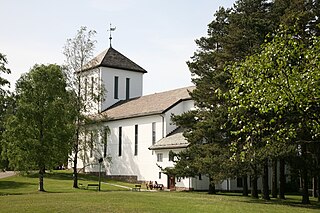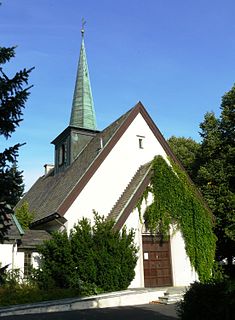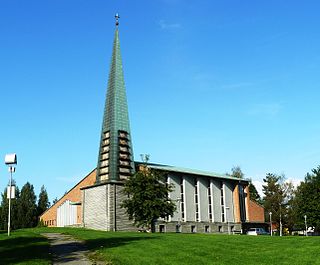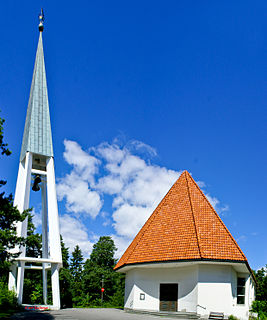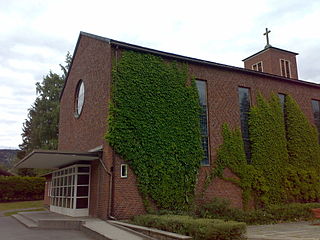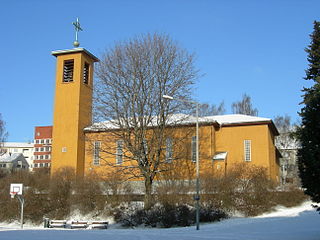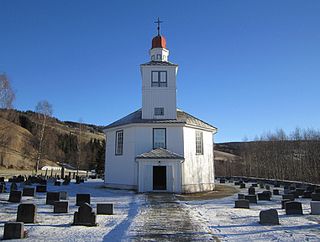| Sinsen Church | |
|---|---|
| Sinsen kirke | |
 | |
| 59°55′55″N10°47′15″E / 59.93194°N 10.78750°E Coordinates: 59°55′55″N10°47′15″E / 59.93194°N 10.78750°E | |
| Location | Lørenveien 13, Sinsen Oslo, |
| Country | Norway |
| Denomination | |
| Churchmanship | Evangelical Lutheran |
| Website | www.sinsenkirke.no |
| History | |
| Status | Parish church |
| Consecrated | 1971 |
| Architecture | |
| Functional status | Active |
| Architect(s) | Turid and Kristen Bernhoff Evensen |
| Specifications | |
| Capacity | 1,000 |
| Materials | concrete |
| Administration | |
| Parish | Sinsen |
| Deanery | Nordre Aker |
| Diocese | Diocese of Oslo |
Sinsen Church (Norwegian: Sinsen kirke) is a church center in Oslo, Norway. The church was consecrated in 1971, and is one of the larger churches in the city. [1] [2] [3]
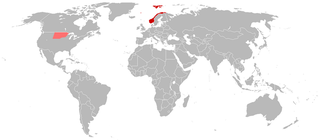
Norwegian is a North Germanic language spoken mainly in Norway, where it is the official language. Along with Swedish and Danish, Norwegian forms a dialect continuum of more or less mutually intelligible local and regional varieties; some Norwegian and Swedish dialects, in particular, are very close. These Scandinavian languages, together with Faroese and Icelandic as well as some extinct languages, constitute the North Germanic languages. Faroese and Icelandic are not mutually intelligible with Norwegian in their spoken form because continental Scandinavian has diverged from them. While the two Germanic languages with the greatest numbers of speakers, English and German, have close similarities with Norwegian, neither is mutually intelligible with it. Norwegian is a descendant of Old Norse, the common language of the Germanic peoples living in Scandinavia during the Viking Era.

Oslo is the capital and most populous city of Norway. It constitutes both a county and a municipality. Founded in the year 1040 as Ánslo, and established as a kaupstad or trading place in 1048 by Harald Hardrada, the city was elevated to a bishopric in 1070 and a capital under Haakon V of Norway around 1300. Personal unions with Denmark from 1397 to 1523 and again from 1536 to 1814 reduced its influence. After being destroyed by a fire in 1624, during the reign of King Christian IV, a new city was built closer to Akershus Fortress and named Christiania in the king's honour. It was established as a municipality (formannskapsdistrikt) on 1 January 1838. The city functioned as a co-official capital during the 1814 to 1905 Union between Sweden and Norway. In 1877, the city's name was respelled Kristiania in accordance with an official spelling reform – a change that was taken over by the municipal authorities only in 1897. In 1925 the city, after incorporating the village retaining its former name, was renamed Oslo.

Norway, officially the Kingdom of Norway, is a Nordic country in Northwestern Europe whose territory comprises the western and northernmost portion of the Scandinavian Peninsula; the remote island of Jan Mayen and the archipelago of Svalbard are also part of the Kingdom of Norway. The Antarctic Peter I Island and the sub-Antarctic Bouvet Island are dependent territories and thus not considered part of the kingdom. Norway also lays claim to a section of Antarctica known as Queen Maud Land.
Sinsen church is built in concrete. The tower structure of the church also houses offices and apartments. In the church room itself, there are 300 seats. This can be expanded with a parish hall, porch and sacristy to approx. 1000. The building also contains a hall, meeting rooms, various activity rooms and kitchens. There is also a kindergarten attached to the church. [2]

Concrete is a composite material composed of fine and coarse aggregate bonded together with a fluid cement that hardens over time—most frequently in the past a lime-based cement binder, such as lime putty, but sometimes with other hydraulic cements, such as a calcium aluminate cement or with Portland cement to form Portland cement concrete. Many other non-cementitious types of concrete exist with different methods of binding aggregate together, including asphalt concrete with a bitumen binder, which is frequently used for road surfaces, and polymer concretes that use polymers as a binder.

Kindergarten is a preschool educational approach based on playing, singing, practical activities such as drawing, and social interaction as part of the transition from home to school. Such institutions were originally created in the late 18th century in Bavaria and Alsace to serve children whose parents both worked outside home. The term was coined by the German Friedrich Fröbel, whose approach globally influenced early-years education. Today, the term is used in many countries to describe a variety of educational institutions and learning spaces for children ranging from one to seven years of age, based on a variety of teaching methods.
The altar decoration is 4.5 meters high and carved in wood by Torvald Moseid. It depicts the crucified Christ flanked by Mary and John. The pulpit and baptismal font are both also in wood and from 1971. The altarpiece was created by Per Vigeland.

Pulpit is a raised stand for preachers in a Christian church. The origin of the word is the Latin pulpitum. The traditional pulpit is raised well above the surrounding floor for audibility and visibility, accessed by steps, with sides coming to about waist height. From the late medieval period onwards, pulpits have often had a canopy known as the sounding board or abat-voix above and sometimes also behind the speaker, normally in wood. Though sometimes highly decorated, this is not purely decorative, but can have a useful acoustic effect in projecting the preacher's voice to the congregation below. Most pulpits have one or more book-stands for the preacher to rest his or her bible, notes or texts upon.
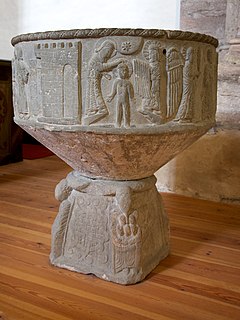
A baptismal font is an article of church furniture used for baptism.
The church organ with 22 voices is created by the Brødrene Torkildsen and the three church bells by Olsen Nauen Bell Foundry. [2] [3]

The Olsen Nauen Bell Foundry is a Norwegian bell foundry located in the municipality of Tønsberg. The foundry was established in 1844 by Ole Olsen, and it is headed today by the sixth generation of the Olsen Nauen family. The company is based at the Nauen farm in Sem and is Norway's only bell foundry.
Sinsen Church is listed by the Norwegian Directorate for Cultural Heritage. [4]

The Directorate for Cultural Heritage is a government agency responsible for the management of cultural heritage in Norway. Subordinate to the Norwegian Ministry of the Environment, it manages the Cultural Heritage Act of June 9, 1978. The directorate also has responsibilities under the Norwegian Planning and Building Law.



